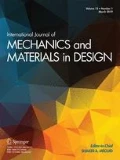Abstract
A method is presented to build reduced (equivalent) models of stiffened panels made of thin-walled composite materials. The technique is developed to be used in the modal analysis of panels and wing boxes, allowing finite element modelling and analysis using a single-type, three-dimensional orthotropic p-element. The use of a single element guarantees speed and flexibility in the (re)modelling of the structure and reduces the modelling and analysis errors connected to finite element analysis in preliminary-design/multidisciplinary-optimization environments. The method is tested on two types of representative wing boxes. Different approaches for the equivalencing are tested and compared to each other. The results show that the equivalent models give results within few percent from those obtained running a full model, saving as much as one order of magnitude in the number of degrees of freedom employed.














Similar content being viewed by others
References
Babuska, I., Suri, M.: Locking effects in the finite element approximation of elasticity problems. Numerische Matematik 62, 439–463 (1992a)
Babuska, I., Suri, M.: On locking and robustness in the finite element method. SIAM J. Numer. Anal. 29, 1261–1293 (1992b)
Babuska, I., Szabo, B., Katz, I.: The p-version of the finite element method. SIAM J. Numer. Anal. 18(3), 515–545 (1981)
Bruhn, E.: Analysis and Design of Flight Vehicle Structures. Jacobs Publishing, Inc., USA (1973)
Collier, C.: Stiffness, thermal expansion, and thermal bending formulation of stiffened, fiber-reinforced composite panels. In: AIAA (ed.) AIAA/ASME/ASCE/AHS/ACS 34th Structures, Dynamics, & Materials Conference, La Jolla, CA. Paper No. AIAA-93-1569 (1993)
Collier, C.: Thermoelastic formulation of stiffened, unsymmetric composite panels for finite element analysis of high speed aircraft. In: AIAA/ASME/ASCE/AHS/ACS 35th Structures, Dynamics, & Materials Conference, Hilton Head, SC. Paper AIAA 94-1579 (1994)
Düster, A.: High order finite elements for three dimensional, thin-walled nonlinear continua. PhD dissertation, Technische Universität München – Lehrstuhl für Bauinformatik (2001)
Gere, J., Timoshenko, S.: Mechanics of Materials. Van Nostrand Reinhold Co. Ltd (1987)
Hughes, T.J.R.: The Finite Element Method: Linear Static and Dynamic Finite Element Analysis. Prentice Hall, Englewood Cliffs, NJ (1987. Reprinted by Dover, NY, 2000)
Jones, R.: Mechanics of Composite Materials, Chapter 2–4. Taylor & Francis, Philadelphia, PA (1999)
Lisandrin, P., van Tooren, M.: High-order finite elements reduced models for use in a flutter design tool. J. Aircraft 42(3), 748–754 (2005)
Morino, L., Mastroddi, F., Bernardini, G., Piccirilli, M.: A hermite interpolation finite element for structural dynamics. In: AIDAA (ed.) XVI Congresso Nazionale AIDAA, Palermo, Italy. Associazione Italiana di Aeronautica e Astronautica (2001)
Stroud, J.: Elastic constants for bending and twisting of corrugation-stiffened panels. Technical report, NASA TR R-166, Langley, VA (1963)
Stroud, J.: Pasco: structural panel analysis and sizing code, capability and analytical foundations. Technical report, NASA TM 80181, Langley, VA (1981)
Stroud, J., Agranoff, N.: Minimum mass design of filamentary composite panels under combined loads: design procedure based on simplified buckling equations. Technical report, NASA TN D 8257, Langley, VA (1976)
Szabo, B., Sahrmann, G.: Hierarchic plate and shell models based on p-extension. Int. J. Numer. Methods Eng. 26, 1855–1881 (1988)
Timoshenko, S.P., Woinowsky-Krieger, S.: Theory of Plates and Shells, 2nd edn. McGraw-Hill Book Company, Inc. (1959)
Author information
Authors and Affiliations
Corresponding author
Rights and permissions
About this article
Cite this article
Lisandrin, P., van Tooren, M. High-order finite elements reduced models for modal analysis of stiffened panels. Int J Mech Mater Des 3, 111–127 (2006). https://doi.org/10.1007/s10999-006-9017-8
Received:
Accepted:
Published:
Issue Date:
DOI: https://doi.org/10.1007/s10999-006-9017-8




